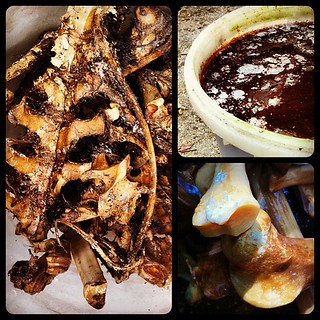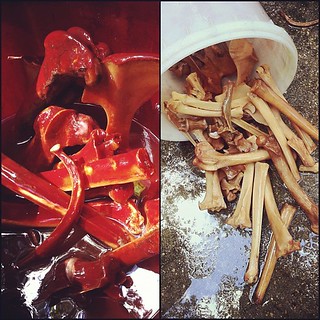I am constantly being asked how long maceration takes and replying "There is no set equation". So I thought it was time for this blog post for some clarification.
It takes as long as it takes. There are a lot of factors that can change the amount of time from start to finish. Time of year, location, size of remains, amount of remains, type of remains, how much flesh/hide is on remains, etc.
Maceration is my preferred method of cleaning bones of flesh, ligaments, soil, etc. It is one of the most gentle methods to use if you want strong, solid bones as the end result. It is literally a form of rotting or putrefaction. Where bacteria removes proteins from the bone. Simply by putting the carcass remains into a sealed container of water.
But it also takes patience. Lots of it. Here are images to explain.

Be safe, be sanitary! I always wear latex gloves when handling the early unsanitary steps of bone processing. Likewise, I prefer to wear a respirator when switching out maceration baths and pulling off tough stuck on skin and hide. That way I can work with it more slowly and carefully rather than rushing it because of the smell.

(click for larger image)
First Image - Nature/insect cleaned deer and wild boar bones with minimal amount of flesh/ligaments/etc. Added to maceration tub. Was filled to the top with water. Then tight fitted lid was replaced. You don't want any big chunks of flesh or pieces of hide/fur/feathers in your maceration tub. Try to remove as much as you can before you begin this process.
Second Image (top) - 3 weeks later the water in the tub was a rusty brown color. This is a good thing. Means the bacteria are doing their work to remove the fleshy bits. Water was NOT switched out that entire time. Sometimes I prefer to switch out the water now and then as it gets cloudy... say once ever other week. Depends on what I have soaking and time of year. As the oils rise to the top of the water and flesh falls off to the bottom, the water will become incredibly nasty/smelly. As it does, pour it out and replace with new clean water. The rule is that once the water is clear, you're done.
When it is colder it slows down the process. It will work best if kept in a warm location. I've read that maceration works best between 35°C/95°F and 50°C/122°F. I'm located in Florida so I can just leave my big maceration tubs sealed outside year round. The process just really slows down through the Winter.
Third Image (bottom) - There are still some meaty bits on the bone and some of the vertebrae were still attached. So not done yet. Threw them back into the bucket and added water and lid again. Takes as long as it takes. Bone processing takes patience. If you are impatient get several projects going in rotation at once. I usually have all stages of the bone cleaning process going at all time. If you are always messing with the bones or worst, cooking them because you're impatient... you are likely damaging them. True story.
Here's another maceration batch example image:

I left this similar batch of bones soaking for at least a month without switching out the water once. It wasn't planned, I was just busy and forgot. The water had turned this amazing blood red color. The bones rinsed off quite nicely and didn't need to macerate any longer.
They did however smell pretty awful. So I put them into a fresh batch of water with some dish soap to help get rid of the smell and to further degrease the bones. Larger bones like these deer/wild boar pieces take a bit more time to degrease. Some animals also seem to have more grease saturated into their bones.
Next step is to sanitize and whiten. Remember, do NOT use chlorine bleach, only hydrogen peroxide. Check out my blog post Bad Words: BLEACH & BOIL for more bone processing HowTo info about this.
---
PRECAUTIONS ABOUT MACERATION ADDITIVES
Some people do use cleaning agents/detergents in their maceration baths to accelerate softening of the flesh and/or encourage grease to come out of the bones. However, I do not. In my experience adding anything manmade to the mix is only chancing weakening the bones. So the below info is just for informational purposes. I do not endorse any of these products.
Sal soda (sodium carbonate) is a water softener that some people use to accelerate softening of the flesh.
Biz is an enzyme-based bleach. Which makes me hesitant to use it personally. But I've had others tell me it works for them.
Oxiclean is a detergent and bleaching agent. I was told it does NOT work very well. Not only did it not get the fatty residue off of the bones but it also DISSOLVED some entire bones!
Borax (sodium tetraborate) is a laundry booster and will turn your bones to mush. So do not use it!
Vinegar will literally turn your bones rubbery. You don't ever want to use it in any step of processing.
The way maceration works is that living bacteria is in the water removing the flesh from the bone. If you put any sort of additional chemical or soap in the water that would likely kill bacteria rather than promote their growth. That just seems counteractive to me.
If you read through the maceration HowTo guide of one of today's biggest bone companies that specializes in selling high quality bones, you'll see they just use water. Nothing more. That to me says all I need to know. See for yourself, here is The Bone Room.
I'll just close with that thought.


